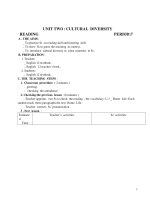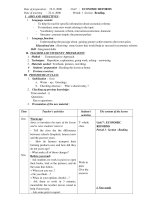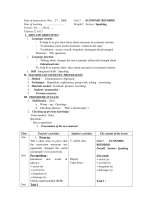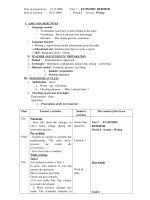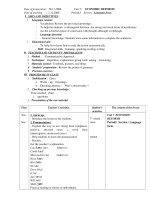Lesson Plan 7 (HKI-II/2008)
Bạn đang xem bản rút gọn của tài liệu. Xem và tải ngay bản đầy đủ của tài liệu tại đây (283.6 KB, 45 trang )
Unit 1 back to school
Date:
Lesson 1 A. Friends (A1,3,4,5)
A. Aims and Objectives:
By the end of the lesson, Ss will be able to introduce themselves and greet
another with: Nice to meet you; How is everything; just fine; not bad; pretty good.
B. Procedures: Absents:
I. Revision: Slap the board.
Treads the Qs, Ss listen and slap the suitable response.
1. What’s your name?
2. How are you to day?
3. What class are you in?
4. Good bye.
5. Are you a new student?
II. New lesson:
1. Practice:
a. Matching: - Get Ss to match the EL phrases with Vietnamese meaning.
- Feed back Ss’ answer.
- Get Ss to read them again.
Pretty good Kh«ng tèt l¾m
How is everything? T«i còng vËy
Nice to see you again Kh¸ tèt
So am I / Me too Mäi viÖc nh thÕ nµo
Just fine RÊt vui khi gÆp l¹i
Not bad B×nh thêng th«i.
b. Gap fill (A
4
)
- Get Ss to read the phases given in the box.
- Let them try to comptete the D (open prediction)
- Feed back Ss’ prediction.
- Let Ss listen and check their prediction.
- Call on several Ss to roleplay the D.
c. Picture cue drill (A
5
)
- Get Ss to look at the pictures given carefully
(who are they? where are they?)
- T reads the dialogues, Ss listen and write the letters of the D in the order they
hear.
- Get Ss to practice in pairs, using the cues above.
2. Mapped dialogue
Hoa Mai
morning … … morning … …
1
Good bye
Yes I am
Class 7
Very well
My name’s Hoa
thanks
Nice again…
too. How ?… … Thanks above … … …
thank you.… Bye
Good bye. See …
Let Ss practice: T – class
H.C <-> H.C
Open pairs Close pairs.
3. Homework: - Role play the mapped dialogue.
- Read text 1 (P.10)
- Do ex 3 (P.4 workbook)
Date:
Unit 1 – Lesson 2 A. Friends (A2)
A. Aims and objectives:
By the end of the lesson, Ss will be able to read for details and revive the simple
present, comparitions alot of/many.
B. Produres: Absents:
I. Old lesson: Get 2 pairs to role play mapped dialogue.
Another pair to do ex3 (WB) complete the D.
II. Revision: Kim’s game.
Uncle, aunt, live, school, student, friend, big, new, old, happy.
III. New lesson:
1. Pre – reading:
a. Vocabulary:
- different (adj) kh¸c, kh¸c biÖt (explanation)
- unhappy (adj) buån, k
o
vui (antonym)
- (to) miss nhí (situation)
- parents bè mÑ (synonym)
- a thing ®å vËt, vËt
Check ROR
b. T/F statement prediction: Order Guess Check
- Hoa is from Hue.
- She lives with her parent in HN.
- She has a lot of friends in HN.
- She missed her friends in Hue.
- Her new school is big.
- She is happy now.
2. While – reading:
- Let Ss read the text (P11) and correct their prediction.
- Feed back and gets Ss to correct false sentenses.
* Comprehension Questions: Lucky number.
1 2 3 4 5 6 7
D LN a f LN e c
a. Hoa is from Hue.
2
b. She is staying with her uncle and aunt.
c. No, she doesn’t have many friends in HN.
d. Her new school is bigger than her old school.
e. She is unhappy because she misses parents and friends.
3. Post – reading:
a. Retell the story:
T gives some cues -> Ss practice retelling the story
From?
Staying with?
Hoa A lot of friends?
Old school & new school?
Happy or unhappy? Why?
b. Transformation writing:
- For weaker Ss: Change “Hoa” to “I”
Ex: I’m a new student in class 7a. I’m from Hue .…
Homework: - ex 1,2 (P3 WB)
- Write a similar paragraph about yourself.
Date:
Unit 1 – Lesson 3 B. Names and Addresses (1,2,3)
A. Aims and objectives:
By the end of the lesson, Ss will be able to ask for and give personal information
(name, age, address).
B. Procedures: Absent:
I. Old lesson: Get Ss write Qs for the answer
a. She is from QB.
b. We are in class 7a.
c. I’m staying with my parents.
d. Nam lives on Tran Hung Dao street.
II. Revision: Noughts & crosses
Your father/40 13 Q.Trung Lan
You/13 his sister, Hoa you/7
4
Le Loi Tan brother/20
III. New lesson:
1. Presentation:
a. Vocabulary:
- family name: hä (example)
- Middle name: tªn lãt ( - )
- first name: tªn gäi (example)
- address: ®Þa chØ (explanation)
3
(to) talk to: nãi chuyÖn (picture)
-> Check: slap the board.
b. Presentation dialogue (B1, P15)
Show the picture in the text book.
? who is that? - Miss Lien
? who are these? - They’re her students
? who is the standing girl? / who is this?
? what is she doing? -> now come to the Dialogue
- T reads the D once.
-> Ss practise reading the D
* Comprehension Question:
T asks Ss answer
a. Hoa is talking to miss Lien
b. It’s Pham
c. It’s Thi
d. She lives at 12 THD street.
2. Practice: word cue drill.
a. Nam / Nguyen / 15 / 32 Ng Du street.
b. Lan / Tran / 12 / Q Trung street.
c. Hoa / Phan / 16 / 17 Le Loi street.
d. Tam / Hoang / 21 / Hoang Dieu street.
Ex: S
1
: What’s Nam’s family name?
S
2
: It’s Nguyen.
S
1
: How old is he?
S
2
: He is 15.
S
1
: Where does he live?
S
2
: He lives at 32 Ng Du street.
-> T <-> class
H.C <-> H.C
Open pairs (2 pair)
Closed pairs
* Complete the D (B2 – P16)
- Review some Question words
- Get Ss to work in pairs: Fill in the blanks to complete the D.
- Feed back Ss’ work.
- Call on some pairs to role play the completed D.
Key: who, who, which (what), where, where, how.
3. Production: B
3
Ask Ss to work in pairs: ask their partner questions and complete the form: name,
age, grade, school, address.
IV. Home work:
- write about your partner, using the information in the form of the production.
4
Date:
Unit 1 – Lesson 4 B. Names and Addresses (4 - 7)
A. Aims and objectives:
By the end of he lesson, Ss will be able to use “How far” questions and answers
“kilometers / meters” to talk about the distance.
B. Procedures: Absent:
I. Old lesson:
- Make full question and answer with: Tran / Hoa / 15 / 20 Tran Phu.
- Another tell about her/his partner.
II. Revision: Word square
Group work: A & B
why, when, on, in, of, from
what, where, by, for
how, who
III. New lesson:
1. Presentation:
a. Vocabulary:
- far (adj) # near : xa (antonym)
- distance (n): kho¶ng c¸ch (explanation)
- transport (n): ph¬ng tiÖn ®i l¹i. (example)
b. Presentation dialogue: (B 4 – P.16)
* Set the scene:
Who are they?
What is this?
Nam wants to know the distance from Hoa’s house
To school so how does he ask in English?
T reads the D once.
- Ss repeat once
- some pairs read again the D (3 pairs)
* Comprehension Questions:
T asks - Ss answer
a. Where does Hoa live? - 12 THD street.
b. Is it far from school? - No, it is not far.
c. How does she go to school everyday? - By bike.
* Model sentences:
How far is it from your house to school?
It’s (about) 1 kilometer.
500 meters.
Concept check: Meaning
Form: How far is it + from to ?… …
5
W W W H Y A
H W H E N O
E B A O N T
R Y T A W F
E I N O F O
N F R O M R
It’s (about) + distance.
Use: Ask & answer about the distance.
Stress.
2. Practice:
a. Word cue drill:
a/ movie theater 15km. c/ post office / 1km
b/ market / 500m d/ bus stop / 3km.
e/ DH station / 700m.
ex: S1: How far is it from your house to the movie theater?
S2: It’s 5km.
b. Picture cue drill: (B5 – P.17)
- Ss practice in closed pairs, using real distances.
- Call some open pairs.
3. Listen and write: (B6 – P.18)
- Get Ss look at the picture cafully.
- Explain how to do this ex.
- T reads
- Ss listen and write the distances
- Feed back.
- Let Ss write the full sentences. (4 sentences)
Ex: It’s about 700m from Lan’s house to the post office.
4. A survey: Work with a partner
Name Nga
Address 20 LL street
Transport By bike
Distance 1km
- T models with one S
- Get Ss work in pairs to complete the table.
Homework: - write about your friend.
- Ex 3,4,5
6
Date:
Unit 2 personal information
Lesson 1 A. Telephone numbers (1 -> 3)
A. Aims and objectives:
By the end of the lesson, Ss will be able to ask for and give telephone numbers
and further practice in addresses.
B. Procedures: Absent:
I. Old lesson:
- Write Q & A about the distance.
a. Hanoi / HCM city / 1500 km.
b. your house / DH station / 400m.
II. Revision: Dictation
T read the telephone numbers, Ss listen and write:
6351739, 8250514, 836769, 0912394859.
III. New lesson:
1. Presentation:
a. Vocabulary:
- a telephone directory: danh b¹ ®iÖn tho¹i (realia)
- (to) call: gäi, gäi ®iÖn tho¹i
b. Presentation text (A3 - P.20)
T point to the picture
? Who are they?
What are they doing?
What are they talking about?
T read the text once.
- Call 3 pairs to practice the D.
- Get Ss to point out the model sentence
Model snetence: What’s your telephone number?
It’s 8262091.
c. Concept check: Meaning
Form: What’s + TTSH + telephone number ?
It’s + number.
Use: Ask & answer about SOS telephone number.
2. Pratice: Word cue drill (A1 – P.19)
Van An / 7345610. Viet Anh / 8269561.
Xuan Ba / 6351793. Thanh Lan / 8276443.
Thi Bang / 9259288.
Ex: What’s his/her telephone number ?
It’s …
3. Further practice: Noughts & crosses
An / 8211800 6 Ng Cong Tru Viet Anh
13 Hoang Dieu Ba / 8231263 Tran Phu street
7
Nga Hoa / 7821652 You / 836289
4. Production: Survey (A3 – P.20)
Get Ss to copy the table.
Name Address Telephone number
Nga 15 Ha Huy Tap 836374
- Let Ss work in groups of 4.
- T models with one Ss -> Ss work in groups.
- Call on several Ss tell about their survey’s result.
Ex: Her name is Nga. She lives at 15 HHT street, her telephone number is 836374.
Homework : Ex 1,2 (P.8 WB)
Date:
Unit 2 – Lesson 2 A Telephone numbers (4,5)
A. Aims and objectives:
By the end of the lesson, Ss will be able to graps the Simple Future Tense “will”
in possitive statements and “wh” question to talk about sure events in the future
B. Procedures: Absents:
I. Old lesson:
Call on 2 students to answer some T’s question about themselves (name, age,
address, phone number, where to live, how to go to school).
II. Revision: Jumbled words
Ese : see, trast : start, vomei : movie, rehatte : theater, emte : meet, tale : late,
romtorow : tomorrow, venenig : evening.
III. New lesson:
1. Presentation:
a. Vocabulary:
- free (adj): r¶nh rçi.
b. Presentation dialogue: (A4 – P.21)
? Who are they?
What are they doing? - They are talking on the tel.
What are they talking about?
- T read the D once, paying attention to “will”; “ll”
- Get Ss to read in choral.
- Call on 3 pairs to practice the D.
c. Comprehention question:
- Get Ss listen T’s questions and give short answers only
a, Phong & Tam.
b, see a movie tomorrow evening.
8
c, at 6:45.
d, In front of the movie theater.
d. Model sentence:
what time will it start?
I’ll start at 7:00.
Where will we meet?
We’ll meet in front of the movie theater.
e. Concept check: Meaning
Form: WH + will + S + V(inf) ?
S + will + V(inf)
(will = ’ll)
Use: Ask & answer about the sure events in the future.
2. Practice:
a. Substitution drill:
where will we meet?
First: Change S: we = I, he, she, it, you, they, Lan, your student.
Second: Change WH - q: Where = who, what time, when, what .…
Third: Change Verb: meet = go
Fourth: Change “Wh - q” and “Verb”: where/meet; what/see; where/go; how/go;
what/do; who/meet.
b. Word cue drill:
1/ where / meet / TP street.
2/ what time / meet / 7:00.
3/ what / see / a film.
4/ how / go / bike.
Ex: S1: where will we meet?
S2: we’ll meet on TP street.
3. Further Practice: Listening (A5 – P.21)
Set the scene: Nga Lan
Explains the requirements of the ex.
Listen and complete the form.
T reads the D, Ss listen and fill They are talking on the phone
in the information.
- Feed back Ss listening.
- Let Ss listen again to check.
Homework: Grasp the structure.
Do ex 3,5 (P.9 wb)
9
Date:
Unit 2 – Lesson 3 A Telephone number (6,7)
A. Aims and objectives:
By the end of the lesson, Ss will be able to use fluently the structure of Simple
Future Tense with “WH - q” and answer.
B. Procedures: Absents:
I. Old lesson: Write full Q & A using will
a, What / do / tomorrow? - Tennis.
b, Who / play with? - Classmates.
II. New lesson:
1. Presentation:
a. Vocabulary:
- (to) be out # be back: ®i khái, ra ngoµi # quay vÒ (example)
- Who is calling? Ai ®ang gäi ®ã? (situation)
- Can I speak to ?… Cho t«i gÆp … (translation)
- I’ll call again: T«i sÏ gäi l¹i (translation)
-> Check: Slap the board.
b. Presentation dialogue:
Let Ss answer some T’s question while looking at the picture.
Who are they in the picture?
Are they playing games now?
What are they doing?
Who are they talking about?
- T reads the D once.
- Some pairs read again.
2. Practice:
a. Comprehension Question: (A6 – P.22)
- Let Ss read the dialogue silently to find out the answer for the Q.
- Ask Ss to play “Lucky number game” to check their understanding.
1 2 3 4 5 6 7
LN c a e LN b t
Key: a, Phong is calling.
b, Han is answering the phone.
c, They are talking about Lan.
d, She’ll be back at about 6:00.
e, Phong will call her again after six.
b. Answer given: Use picture of A7, P23 to set the scene.
- At five thirty -> What time will be the party start?
- We’ll eat cakes and sweets -> What will we eat?
- Till 7:30 -> How long will the party last?
- We’ll meet in the street -> Where will we meet?
In 2 groups.
10
T feeds back Ss’ questions.
3. Production: Mapped dialogue
Hoa Lan
What do tomorrow?…
What watch?…
Yes, when start?…
Where meet?…
Ok. Bye
… go stadium…
… a soccer match
Would with me?…
3.30 / meet 3.15… …
… front stadium…
Bye. See …
Homework: Learn by heart the mapped dialogue; Do ex 4.
Date:
Unit 2 – Lesson 4 B. My birthday (1,2,3,9)
A. Aims and objectives:
By the end of the lesson, Ss will be able to talk about the days of the years and
the pronunciation.
B. Procedures: Absent:
I. Old lesson: Call on 2 pairs to practice the mapped dialogue.
II. Revision: Pelmanism
1st 2nd 10th 5th 3rd 9th
first second tenth fifth third nine
III. New lesson:
1. Presentation:
a. Vocabulary:
Twelfth: 12
th
. => check: ROR
Twentieeth: 20
th
. Jumbled words.
Twenty first:21
th
.
Thirtieth: 30
th
.
Thirty first: 31
th
.
b. Guess the new words: (B3 – P.24) Poster:
“Months of the year” January th¸ng 10
- T hangs a poster on the board February 7
- Get Ss (one by one) go to the board March 5
and match EL words with Vietnamese April 12
meaning. May 1
- Feed back Ss’ work. June 4
- Let Ss pronunce the months July 6
In chorus -> individually. August 9
September 2
October 11
November 3
December 8
11
2. Practice:
a. Listen and write the dates:
Explains how to finish the exercise: T reads some dates, Ss listen carefully and
write the dates in pairs. After each time of listening, feed back Ss’ answer.
The first of July, the second of September, the twentieth of November, the thirty
first of December, the fifth of September.
b. T gives some dates, Ss practice saying the dates.
19/5 03/02 27/7 01/01 04/7 22/12.
3. Production: A Survey
Get Ss work in groups of 4 after copying the table.
Name Birthday
Nga October
Ex: When is your birthday?
It’s on the fifteenth of October.
Homework: - Learn by heart 12 months of the year.
- Ex 1,2 (P.10 wb).
Date:
Unit 2 – Lesson 5 B. My birthday (4,5)
A. Aims and objectives:
By the end of the lesson, Ss will be able to develop listening skill
- practise reading skill.
B. Procedure: Absent:
I. Old lesson: 2 Ss write the dates in English.
5/9 20/11 1/5 22/12
II. Revision: “Bingo”
- Let Ss write some months of the year (5 months)
- T reads the month, Ss listen and tick their writing.
III. New lesson:
1. Pre – listening:
a. Vocabulary:
- date of birth = birthday. (synonym)
- nervous (adj): lo l¾ng, bån chån (example)
- (to) worry (about): lo, lo ©u (situation)
- won’t = will not: sÏ kh«ng
Check: what & where
b. Open prediction:
Who is this?
What do you remember about Hoa
- Let Ss predict and fill in the registration about Hoa
(full name, date of birth, address, phone number)
12
- Feed back Ss’ prediction.
2. While – listening:
a. Listening and checking the prediction:
- T read the D (P.25), Ss listen carefully and check their prediction.
- Feed back Ss’ listening
Let Ss listen again to check.
Answer key: Registration Form student.
Name: Pham Thi Hoa.
Age: 13.
Date of birth: Tune 8
th
.
Address: 12 Tran Hung Dao street.
Tel: 8262019.
b. Comprehension Q:
- Let Ss listen the D again to find the answers for 5 Qs in B4
- Get Ss to play “LN” game to check their answers.
3. Post listening: Write it up.
- Run through the police record (ex8, P.41)
- Let them write full Q and answer about Mr Hung (4 Qs 8 4As) after
practising speaking with their partner.
Homework: - Write about your self (B4, P.25 f -> h)
- ex:
Date:
Unit 2 – Lesson 6 B. My birthday (6,7)
A. Aims and objectives:
By the end of the lesson, Ss will be able to write an invitation to a party.
B. Procedures: Absent:
I. Old lesson: Write Qs and As with
Lan / 14 / August 17 / 20 THD street.
II. Revision: LN game.
1./ What’s your family name? 6./ What is your date of birth?
2./ How old are you? 7./ Who do you live with?
3./ LN 8./How old will you be on your next birthday?
4./ What’s your address? 9./ LN
5./ What’s your telephone number? 10./ LN
III. New lesson:
1. Pre – writing:
a. Vocabulary:
- (to) have a party: tæ chøc buæi tiÖc (picture)
- (to) invite: mêi (translation)
- an invitation card:thiÖp mêi picture
Check: ROR
b. Reading:
13
T: To day we’re going to read a text about Lan.
T reads the text.
- Call on several Ss to read the text.
- Get Ss to answer some T’s questions.
? How old is Lan now? 12
How old will she be on her next birthday? 13
When is her birthday? May 25
th
.
Where will the party be? At her house.
What is her address? 24 LT Kiet
How long will the party last? From 5pm to 9 pm.
2. While writing:
a. Gap fill: (B6 – P27)
- Get Ss to use the information from the text and the answers to complete the
invitation card.
Key: 2./ 24 Ly Thuong Kiet street 3./ From 5 to 9 pm
1./ Sunday May 25
th
. 4./ Lan
- Let Ss swap their writing to each other and correct.
b. Questions and Answers: (B7 – P27)
- Let Ss answer the Q in full answers.
- Get Ss to join their answers to form a paragraph.
- Call on several Ss read their paragraph in front of the class.
3. Post – writing: (B8 – P27)
Get Ss to write an invitation to their birthday party
work arragment : individually.
Homework: Write an invitation to your birthday party
Prepare for the new lesson.
14
Date:
Unit 3 at home
Aims of the Unit: By the end of the unit Ss will be able to:
- Describe the rooms in the house with “there is/are”
- Make a complaint and compliment exclamations.
- Talk about comparisions, using comparative & superlative.
Lesson 1 A. What a lovely home ! (1,3)
A. Aims and objectives:
By the end of the lesson, Ss will be able to know some bathroom and kitchen
vocabulary. Then use them to describe the room using “There is / are”.
B. Procedures: Absent:
I. Old lesson: Make Qs for the following sentences:
1. I’ll be 13 on my next birthday.
2. He’ll go to school by bike.
3. The party will be at my house.
II. Revision: Kim’s game.
a stove, a clock, a picture, a table, a chair, a couch, an armchair, a lamp, a
bookshelt, a television.
III. New lesson:
1. Presentation:
Brain storm: How many rooms are there in your house?
What are they? Dinningroom toilet
Bathroom livingroom
Bedroom kitchen
Today we’re going to learn some vocab about the things in the kitchen and bathroom.
a. New words:
15
a house
- a dryer: m¸y sÊy kh« (explanation)
- a sink: bån röa (picture)
- a tub: bån t¾m ( “ )
- a refrigeration: tñ l¹nh (explanation)
- a washing machine: m¸y giÆt (picture)
- a dish washer: m¸y röa b¸t (translation)
- an electric stove: bÕp ®iÖn ( “ )
b. Check: Rearrange the things in to the rooms
- a kitchen - a bathroom
+ a stove + a tub
+ a dish washer + a sink
2. Practice:
1, T / F repeattition drill: (P.31)
Hangs on the board the picture of the living room
Which room is it? Living room.
Can you see the things clearly?
What are there in the room?
T describes the room. Ss listen carefully and repeat the T’s description if they are
True.
- Call on 3 Ss to describe the picture (T point to the things)
2, Delibrate mistakes:
- T hangs the picture about the kitchen on the board (P.30)
- Run through vocab in the picture.
- T describes the picture but there are some mistakes in the description. Ss listen
carefully and say “No” when thay hear a mistake.
3. Production:
1, Chaingame (the kitchen)
Get Ss to work in group of 4
S1 There is a stove in the kitchen
S2 There is a stove and a sink in the kitchen
S3 …
2, Language focus (7 P.41)
- Let Ss see the picture carefully
- Get them to fill in the gap with “Is there a / Are there any ”… …
Homework: Learn by heart the new words.
Date:
Unit 3 - Lesson 2 A. What a lovely home ! (1,2 b)
A. Aims and objectives:
By the end of the lesson, Ss will be able to make exclamatory sentences for
complement using “What + a/an + Adj + N” to talk about the house.
B. Procedures: Absent:
16
I. Old lesson: Call 2 Ss to write the vocab in Lesson 1.
II. Revision: Kim’s game
A tub, a dishwasher, a sink, a shower, a washing machine, a chair, a bathroom, a
kitchen, a refrigerator.
III. New words:
1. Presentation:
a. Vocabulary:
- delicious (adj): ngon (real object)
- interesting (adj): hay, thó vÞ (explanation)
- modern (adj): hiÖn ®¹i
- comfortable (adj): tho¶i m¸i
- amazing (adj): ng¹c nhiªn
- bright (adj) : s¸ng sña
- convenient (adj): thuËn tiÖn
Check: ROR
b. Presentation Dialogue:
T reads the text once
Call on 2 pairs to read the D
Let Ss answer some T’s question about the content of the text (A1, P 30)
Let Ss point out the model sentence.
What a beautyful bathroom.
What an amazing kitchen.
c. Concept check: Meaning
Form: Exclamative sentence
What + (a/an) + Adj + N !
Use: Khen ngîi ai, c¸i g×.
Stress: put stress on Adj.
2. Practice: Word cue drill
Story / interesting S1: The story is very interesting
Armchair / comfortable S2: Yes, what an interesting story
Livingroom / bright T models, Ss repeat
Dinner / delicious T say the first sentence
Kitchen / convinient S make exclamative sentences
Ss practice in pairs.
3. Further Practice: Write it up.
T say some sentences, Ss make exclamative sentences.
Ex: The house is nice -> What a nice house
The weather is very warm -> what warm weather
Let Ss write compliments, using the cues in 2b, P31.
Homework: New words
Ex b2 (P.31 Text book)
Date:
17
Unit 3 - Lesson 3 A. What a lovely house (2a)
A. Aims and objectives:
By the end of the lesson, Ss will be able to make exclamative sentences for
complaints, plural N and Uncountable N.
B. Procedures: Absent:
I. Old lesson: Write exclamative sentences for:
The day is very beautyful.
The room is very lovely.
II. Revision: Jumbled words
- tgbirh : bright - leoudicis : delicious
- dogo : good - tetinirgesn : interesting
- tieaufull : beautiful - levylo : lovely
III. New lesson:
1. Presentation:
a. Vocabulary:
- awful (adj): kinh khñng, tåi tÖ (translation)
- expensive (-): ®¾t (picture)
# cheap (-): rÎ (antonym)
- bad (-): xÊu, tåi, dì # good( - )
- boring (-): ch¸n, dì # interesting ( - )
Check: Slap the board
b. Presentation Picture: (P.30)
- Hang the picture on the board.
Where is it? It’s a clothing store.
What are those? They are shirt.
How much are they? 50.000d
What are these? They’re dresses.
How much are they? 250.000d
What does she want, a shirt or a dress? A dress.
Is it cheap or expensive? Very expensive.
How do you say in EL?
What an expensive dress!
Concept check: Meaning
Form: What + (a/an) + Adj + N!
Use: Express the complaint.
Note: - What + Adj + Ns/Unc N !
- The difference between exclamatory for compliments
and complaints (depend on Adj)
2. Practice: Word cue drill
- wet / day bad / restaurant
- boring / party expensive / car
- awful / weather naughty / boys
Small / houses
18
